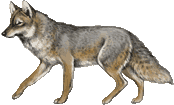|

Family Canidae
Canis latrans
Description: Grayish brown with varying degrees of red on legs, feet, and ears; pointed muzzle; bushy tail; 32
to 40 inches long; 14-inch tail; 30 to 50 pounds.
Similar species: Red fox-reddish in color; holds tail straight when running. Gray fox-smaller; holds tail out straight
when running.
Habitat/Distribution: Common throughout the region and in RMNP in open prairies, desert habitats, forests, subalpine
and alpine habitats, often found in close proximity to farms, ranches, and suburban areas.
Food: Both carnivores and scavengers-feed on small rodents, grasshoppers, carrion, various fruits and berries;
sheep and other domestic livestock are taken on occasion.
Often nicknamed "song dog," coyotes are extremely vocal. Their howling and yipping are commonly heard
at dusk and serve as a means of communication. Their vocalizations often betray their presence even where the animals
themselves are never seen. Its Latin name, Canis latrans, literally means "dog barking."
Creatures of the open, coyotes den up only when they have pups. Although they may seek shelter from the hot sun
or heavy rain, their dense coats protect them from everything else.
Coyotes are monogamous and often mate for life. Breeding occurs in February or March. Dens are found or dug under
large boulders, in crevices and caves in rocky outcroppings, or in hillsides or banks. The same den may be used
from year to year unless the pair is disturbed. From four to seven pups are born in April and progress rapidly
from a diet of milk to small mammals. By three to four weeks old, they begin venturing out of the den to play.
By eight to nine weeks, they begin following the parents and learn to hunt. At about this time they are weaned
and the den is abandoned.
Because coyotes will feed on any plentiful food source, they often take lambs from nearby flocks of domestic sheep.
It is no surprise that they are hated and often persecuted by the affected ranchers. In spite of continuing persecution
by man and encroaching civilization, coyotes are flourishing.
|